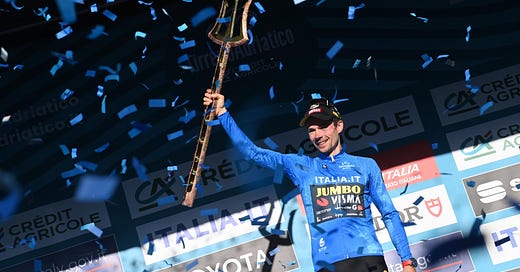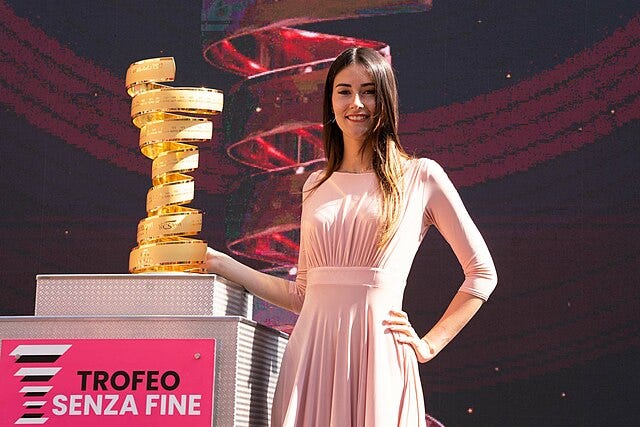Bring Me the Tirreno-Adriatico Trident So That I May Wield It Against the Forces of Wickedness
Practical applications for the mightiest trophy in sports.
On Friday, I hyped up Strade Bianche as the best one-day race on the calendar, and suggested that maybe Tadej Pogačar would be too rusty to win it, given that he had zero days of racing in his legs to that point.
Pogačar said in a pre-race interview that he was going to attack on the long gravel section some 80 kilometers from the finish, and I think people thought he was at least half-kidding. They don’t have Babe Ruth in Slovenia; there’s no way Pog would know about the concept of calling one’s shot.
But sure enough, that’s exactly what he did. The first chase group featured one or two strong riders from almost every team, but nobody with the kind of numbers to mount a serious, sustained chase over rocky, undulating1 terrain. So Pog rode off into the sunset, for 80 kilometers, without ever being challenged. The last two and a half hours of the three-hour television coverage were devoted to describing something that had already happened. An impressive, well-deserved victory, but from an entertainment perspective it made the processional Bahrain Grand Prix—which was taking place at the same time—look as gripping and uncertain as The Usual Suspects.
So I’m taking a short break from prognosticating, because clearly I stink at predicting the future.
Let’s talk about winning. It matters that you win. It matters where you win. And to most people, it matters how you win.
But in most cases, victory is its own reward. To be known as a champion is enough. It matters less what you win. The rewards for the victor—money and accolades—are greater than for any other finishing position. Rare is the occasion when an athlete looks at the spoils and says, “Nah, not worth the effort.”
And to be honest, this lack of attention allows lazy design to flourish. Particularly in North America. College football, the NFL, and the NBA all just have a lazy representation of a ball on a smooth base clad in shiny metal. This is what I like to call the Property Brothers school of design: Selling the cheapest possible construction method as fashionable. People don’t want open concept and a gray backsplash. You’re being lied to. Don’t piss on my head and tell me it’s minimalism.
MLB commissioner Rob Manfred got in trouble a while back for calling his sport’s championship bauble, the Commissioner’s Trophy, a “piece of metal.” The objection—that Manfred was denigrating the pursuit of victory, and giving voice to the fact that his corporation’s raison d’être was no longer baseball as such but real estate speculation—is valid. But on aesthetic grounds, ol’ Bobbers is right.
I mean what the frig is this? You can’t really hoist it, you can’t drink from it, you can only impale yourself on it. The best trophy in baseball is the Claxton Shield, the enormous, um, shield that’s given to the winner of the Australian Baseball League.
A great trophy has to have at least two of the following qualities: It has to be pretty, it has to be venerable, and/or it has to be wearable/useable.
To be honest, sometimes one is enough. America’s Cup is this hideous Victorian relic, but it’s been around since the 1850s and is synonymous with the sport, so it’s iconic.
But if you can get all three, man. That’s something special. Take the Stanley Cup, which is as synonymous with hockey as America’s Cup is with securities fraud yacht racing. It’s so revered that merely touching it is a holy act in hockey circles, and champions work their entire lives just to hoist it for a few seconds on the ice, and spend a day with it in the offseason.
It’s the best trophy in sports. The only thing that comes close, to me, is an Olympic medal. Again, hundreds of years of history. (Thousands, if you go hog wild on the mythology.) Winning one is a ticket to immortality, and best of all, you can bring it anywhere. I don’t know of anyone who’s blasé about an Olympic medal—like the Stanely Cup, it’s an immediately identifiable sacred object.
Much like a champion’s jersey in cycling. Good news: Cycling, by and large, has good trophies.
Most famous among them are the various champion’s jerseys, especially the maillot jaune. There’s a lot to criticize about western military tradition, but one thing I think it gets right is that wearing evidence of one’s achievements kicks major ass. Soldiers have their Medal of Honor or Purple Heart or whatever; cyclists have the yellow jersey or the rainbow jersey. It passes the Stanley Cup Test: Do people talk about winning a championship, or do they talk about winning the trophy as a metonym? You don’t win a Tour de France title; you win a yellow jersey. You don’t win a world championship; you win the rainbow jersey. The maglia rosa, not the Giro, and so on.
Also, these jerseys usually look good, which is secondary but nonetheless important. Bright, distinctive colors always play.
As if that weren’t enough, cycling races give out great trophies as well. If you win Paris-Roubaix, the trophy is a mounted cobblestone, which first of all fits with the rugged reputation of the race. But it’s also a trophy in an ancient sense: You killed the bumpy road, so now you get to carve out part of it and mount it over your fireplace, like Grendel’s arm or a piece of the Aggro Crag.
At the grand tours, the trophies are prettier and more modern. Well, two of them are. The Vuelta winner gets a glass plate with a decal of the race route on it, which is frankly disgraceful.
But Tour de France winners, in addition to the maillot jaune get an elegant glass vase, and Giro winners get the Trofeo Senza Fine, this gorgeous copper ribbon. It can be hefted, toted, tilted, anything you’d want from a trophy. It even sits at a slight angle like the Leaning Towner of Pisa. Nothing else looks quite like it. It’s legitimately one of my favorite trophies in any sport.
Okay, a thousand words into the blog and we’re finally going to get to the news hook. This week is the proper start of stage racing in Europe, with Paris-Nice underway in France and Tirreno-Adriatico in Italy. These are the two biggest early stage races of the year, and two of the most prestigious stage races anywhere outside of the grand tours. Primož Roglič and Remco Evenepoel are at Paris-Nice, while Jonas Vingegaard, Richard Carapaz, Enric Mas, and Juan Ayuso are all on the start line at Tirreno. Most of the grand tour contenders, if healthy, are at one of these races.
Incidentally, I also like that a lot of the big stage races—Paris-Nice and Tirreno for sure, but also Tour de Suisse and the Dauphiné—kick off two at a time. So it feels like the big dogs are ducking each other before the grand tours.
Anyway, both of these races have a geography-based nickname. Paris-Nice2, which starts in central France and goes south to the Riviera, is “the Race to the Sun.” The trophy? This abstract representation of a sun.
I guess that looks like…brass? With a glass or polycarbonate rim? Either way, I think that’s a pretty nifty prize. It’s distinctive and pretty.
On to Tirreno-Adriatico, which follows the cycling convention of naming a race after its start and finish points. Except instead of using cities, like Paris-Nice, this race goes from the Tyrrhenian Sea on Italy’s west coast, to the Adriatic Sea on its east coast. So people call it “the Race of the Two Seas.”
And the organizers really sell this maritime gimmick. Because in contrast to the traditional yellow race leader’s jersey, Tirreno-Adriatico uses blue. That’s pretty cool, not many races do that.
But the race winner’s trophy?
IS A FUCKING TRIDENT.
YOU GUYS!
There’s selling a banding strategy, and then there’s distributing the sea-god’s regnal war fork as a trophy.
If I won an Olympic gold medal that’d be cool. I’d show it off to impress strangers and keep it in a shadow box in my study and put it on whenever I felt my self-esteem getting low.
If I won Tirreno-Adriatico I would use the trident in the following applications:
Take it to the nearest seafood restaurant and play air guitar on it
Take it spearfishing and/or flounder gigging
Menace my unfriendly neighbors
Fly down to Florida and use its magical powers to speak to manatees
Fight crime in coastal cities
Fight piracy on the high seas
Go to Shop Rite and liberate the tank of live lobsters
Maybe cut my musically talented hoarder youngest daughter a little slack. I know it’s tough being a single dad with seven kids, but you’ve got to at least make your kids feel like they’re being heard. Otherwise they’ll sell their voice to a voluptuous sea-witch in exchange for legs and run off with some prick they’ve only ever met once. Best-case scenario your kids grow up to resent you and don’t let you see your grandchildren.
Make the world’s largest s’mores
Make the world’s largest kebab
Eat one or both off the Vuelta a España plate
Mount it to the roof of my car and drive around like the nautical version of the old Red Bull Mini Cooper
Defeat the evil galactic emperor’s troops with their goofy-looking time trial helmets
Win a bunch of triathlons
Enforce a 200-nautical mile exclusive economic zone in accordance with the 1982 UN Convention on the Law of the Sea
Aid the orcas in their fight against yachts
Aid the seals in their fight against orcas
Get really good over-the-air TV reception
Win the Stanley Cup, mix the world’s largest martini, and use the trident as an olive skewer
You see how far down the list we get before “win the Giro d’Italia” even crossed my mind. The Trofeo Senza Fine and the maglia rosa are as beautiful a combination of prizes as you’ll ever win, but they’re not a trident.
Cycling commentators use “undulating” 50 times more often, on average, than your typical English-speaker.
In my 8th grade French textbook, the chapter on geography had a photo taken at a topless beach in Nice. Even in a progressive public school in New Jersey, this caused quite a stir among the class.









